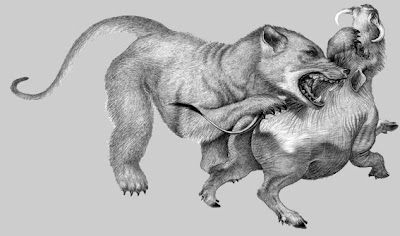 Amphicyonidae is an extinct family of large terrestrial carnivores belonging to the suborder Caniformia (meaning "dog-like") and which inhabited North America, Europe, Asia, and Africa from the Middle Eocene subepoch to the Pleistocene epoch 46.2—1.8 Mya, existing for approximately million years.Amphicyonids, often referred to as "bear
Amphicyonidae is an extinct family of large terrestrial carnivores belonging to the suborder Caniformia (meaning "dog-like") and which inhabited North America, Europe, Asia, and Africa from the Middle Eocene subepoch to the Pleistocene epoch 46.2—1.8 Mya, existing for approximately million years.Amphicyonids, often referred to as "bear
dogs", crossed from Europe to North America during the Miocene epoch and are considered an Old World taxon. The earliest to appear is the (rather large)Ysengrinia (30—20 Mya), followed by Cynelos (24—7 Mya) and Amphicyon (23—5 Mya). These animals would have followed ungulates and other mammals to the New World for a period of approximately 7 million years. The New World amphicyonids of the subfamilies Daphoeninae (42-16 Mya) and Temnocyoninae (33-20 Mya) coexisted with the Old World counterparts. Note that the (often similar looking) members of the family Hemicyonidae are often called "bear-dogs" as well (although they are increasingly referred to as "dog-bears" to avoid confusion).While amphicyonids have traditionally been viewed as closely related to ursids (bears), some evidence suggests that they may instead be basal caniforms. (Hunt, 2004b). They were about as tall as the American black bear and were most likely ambushers because their legs were made for short, sudden bursts of speed. Bear-dog also nested their young in underground burrows.During the early Miocene, a number of large amphicyonids migrated from Eurasia into North America. These taxa belong to the Old World amphicyonid sub-family Amphicyoninae. The earliest to appear is the large bear dog Ysengrinia Ginsburg, followed by Cynelos Jourdan, and then by Amphicyon. This influx of amphicyonines, accompanied by other Old World ungulates and small mammals, indicates a prolonged interval (from 23 to 16.5 Ma) of faunal exchange between Asia and North America in the early Miocene, using the trans-Beringianroute.New World daphoenines (Daphoenodon, Borocyon) and temnocyonines coexisted with Old World amphicyonines (Ysengrinia, Amphicyon, Cynelos) 23.7-17.5 million years ago. These are the largest terrestrial carnivorans 50 kilograms (110 lb) to 200 kilograms (440 lb) that evolved on the North American continent up to this time. The immigrant
amphicyoninesYsengrinia, Cynelos and Amphicyon appear at 23, 19.2, and 18.8 Ma, respectively, and herald the beginning of a Eurasian amphicyonine migration into North America that continued into the mid-iocene.Amphicyonids were as small as 5 kilograms (11 lb) and as large as 100 to 600 kilograms (220 to 1,300 lb) and evolved from wolf-like to bear-like.The diet of the amphicyonids was fully carnivorous as opposed to hypercarnivorous to mesocarnivorous in Canidae.
